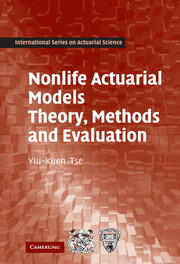Book contents
- Frontmatter
- Contents
- Preface
- Notation and convention
- Part I Loss models
- 1 Claim-frequency distribution
- 2 Claim-severity distribution
- 3 Aggregate-loss models
- Part II Risk and ruin
- Part III Credibility
- Part IV Model construction and evaluation
- Appendix: Review of statistics
- Answers to exercises
- References
- Index
1 - Claim-frequency distribution
from Part I - Loss models
Published online by Cambridge University Press: 05 June 2012
- Frontmatter
- Contents
- Preface
- Notation and convention
- Part I Loss models
- 1 Claim-frequency distribution
- 2 Claim-severity distribution
- 3 Aggregate-loss models
- Part II Risk and ruin
- Part III Credibility
- Part IV Model construction and evaluation
- Appendix: Review of statistics
- Answers to exercises
- References
- Index
Summary
This book is about modeling the claim losses of insurance policies. Our main interest is nonlife insurance policies covering a fixed period of time, such as vehicle insurance, workers compensation insurance, and health insurance. An important measure of claim losses is the claim frequency, which is the number of claims in a block of insurance policies over a period of time. Though claim frequency does not directly show the monetary losses of insurance claims, it is an important variable in modeling the losses.
In this chapter we first briefly review some tools in modeling statistical distributions, in particular the moment generating function and probability generating function. Some commonly used discrete random variables in modeling claim-frequency distributions, namely the binomial, geometric, negative binomial, and Poisson distributions, are then discussed. We introduce a family of distributions for nonnegative, integer-valued random variables, called the (a, b, 0) class, which includes all the four distributions aforementioned. This class of discrete distributions has found important applications in the actuarial literature. Further methods of creating new nonnegative, integer-valued random variables are introduced. In particular, we discuss the zero-modified distribution, the (a, b, 1) class of distributions, the compound distributions, and the mixture distributions.
- Type
- Chapter
- Information
- Nonlife Actuarial ModelsTheory, Methods and Evaluation, pp. 3 - 40Publisher: Cambridge University PressPrint publication year: 2009

